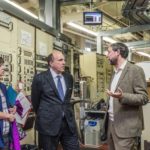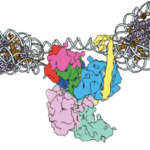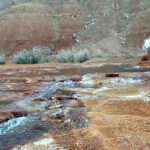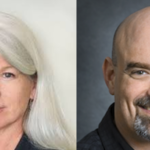In two new studies, a team of researchers led by Eva Nogales, senior faculty scientist in the Molecular Biophysics and Integrated Bioimaging (MBIB) Division, has gained insight into the structure and function of molecules that act at the genetic level to give rise to different types of cells.
JGI Helps Track Microbial Diversity Through the Terrestrial Subsurface
In collaboration with a team led by longtime collaborator Jill Banfield of the University of California, Berkeley and Cathy Ryan of the University of Calgary in Canada, JGI researchers investigated samples collected at Utah’s Crystal Geyser over one of its complex, five-day eruption cycles. Genome-resolved metagenomics, single-cell genomics, and geochemical analyses were integrated to show that samples taken during each phase contain microbial communities that are distinctive in terms of both composition and metabolic function. The report was published January 29, 2018 in Nature Microbiology. Read the full story on the JGI website.
Diversity Senior Leadership Council Launched at the Lab
Berkeley Lab Director Witherell, in partnership with the Diversity, Equity, and Inclusion (DEI) Office, has announced the launch of Berkeley Lab’s DEI Senior Leadership Council (SLC). Members of the council include Biosciences Associate Laboratory Director Mary Maxon and Biological Systems & Engineering Division Director Blake Simmons. They, along with ten other councilmembers, will provide senior leadership with support and guidance toward achieving the Lab’s strategic DEI goals.
In his announcement, Witherell said that the SLC “will help carry out our commitment to ensure that diversity, equity, and inclusion become hallmarks of the Berkeley Lab culture. This council will provide senior management’s support and guidance toward achieving the Lab’s strategic DEI goals. The leadership and perspectives of our council members will be invaluable as we move forward with our strategy and vision for our organization.” Go to the DEI website to learn more.
TEDx Talk by BSE’s Director Blake Simmons Now Available
 Blake Simmons, Director of the Biological Systems and Engineering Division, gave a talk at TEDxSonomaCounty on November 4, 2017 entitled “A World Without Limits through Biomanufacturing of Carbon”. The video of the talk is now available.
Blake Simmons, Director of the Biological Systems and Engineering Division, gave a talk at TEDxSonomaCounty on November 4, 2017 entitled “A World Without Limits through Biomanufacturing of Carbon”. The video of the talk is now available.
DOE Under Secretary for Science Paul Dabbar Visits Biosciences Area
 Paul Dabbar, Department of Energy’s Under Secretary for Science, visited Berkeley Lab on January 18. The visit focused namely on the Lab’s industry engagement programs. During the visit, Dabbar heard presentations by Mary Maxon, Associate Lab Director for Biosciences, and Blake Simmons, Division Director for Biological Systems and Engineering. Paul Adams, Division Director for Molecular Biophysics & Integrated Bioimaging welcomed Dabbar at the Advanced Light Source, and Todd Pray, Program Head of the Advanced Biofuels and Bioproducts Development Unit gave a tours of its facilities. The visit also included tours of the Integrative Genomics Building construction site and the Joint Bioenergy Institute.
Paul Dabbar, Department of Energy’s Under Secretary for Science, visited Berkeley Lab on January 18. The visit focused namely on the Lab’s industry engagement programs. During the visit, Dabbar heard presentations by Mary Maxon, Associate Lab Director for Biosciences, and Blake Simmons, Division Director for Biological Systems and Engineering. Paul Adams, Division Director for Molecular Biophysics & Integrated Bioimaging welcomed Dabbar at the Advanced Light Source, and Todd Pray, Program Head of the Advanced Biofuels and Bioproducts Development Unit gave a tours of its facilities. The visit also included tours of the Integrative Genomics Building construction site and the Joint Bioenergy Institute.
- « Previous Page
- 1
- …
- 132
- 133
- 134
- 135
- 136
- …
- 214
- Next Page »
Was this page useful?






